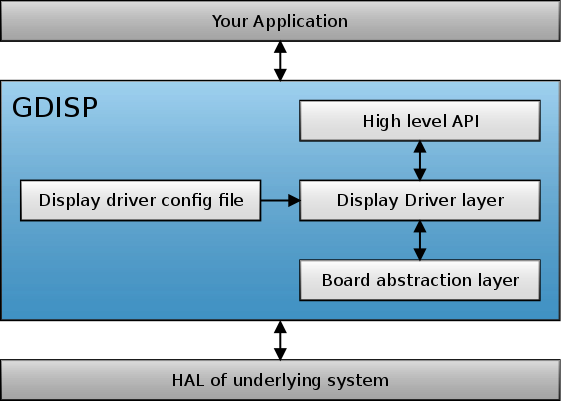Difference between revisions of "GDISP"
(→Drawing) |
(→Board file) |
||
| Line 9: | Line 9: | ||
Especially interesting might be the use of one or more [[GDISP#Remote_Displays|remote displays]]. | Especially interesting might be the use of one or more [[GDISP#Remote_Displays|remote displays]]. | ||
| + | |||
| + | == API reference == | ||
| + | The API reference of the GDISP module can be found [http://ugfx.org/images/resources/doxygen/master/group___g_d_i_s_p.html here]. | ||
== Board file == | == Board file == | ||
Revision as of 00:39, 3 July 2014
The GDISP module provides a simple interface for graphic displays and a feature rich set of highlevel functions to draw primitive shapes such as lines, circles and rectangles, but also font rendering, clipping and other advanced features.
Whilst most other graphics libraries require the use of a framebuffer, GDISP does not necessarily need one. This allows to drive graphics displays on microcontrollers and other low-performance systems that have insufficient RAM for a frame buffer.
Some LCD controllers offer hardware accelerated drawings for complex drawing operations such as circles or ellipses. The GDISP module is based on a software emulation layer: When the LCD controller does not support these features (most cases), the GDISP module emulates these drawing operations. Therefore, the exact same application code can be used on very different hardware platforms.
Furthermore, you can drive more than just one display with GDISP. They don't even need to have the same display driver. Please refer to the multiple displays section for more information. Especially interesting might be the use of one or more remote displays.
Contents
API reference
The API reference of the GDISP module can be found here.
Board file
The board file API for the GDISP module looks like the following:
static void init_board(GDisplay *g); static void post_init_board(GDisplay *g); static void setpin_reset(GDisplay *g, bool_t state); static void set_backlight(GDisplay *g, uint8_t percent); static void acquire_bus(GDisplay *g); static void release_bus(GDisplay *g); static void write_index(GDisplay *g, uint16_t index); static void write_data(GDisplay *g, uint16_t data); static void setreadmode(GDisplay *g); static void setwritemode(GDisplay *g); static uint16_t read_data(GDisplay *g);
For more information about the, see GDisplay.
Examples and a template file can be found under /drivers/gdisp/xxx/.
Controlls
It's possible to modify panel parameters such as the orientation, backlight or contrast through highlevel API. But before you can use any of the following features, you have to enable the GDISP_NEED_CONTROLL macro in your gfxconf.h first:
#define GDISP_NEED_CONTROL TRUEPlease note that all these features are optional. Not every GDISP driver may have all of the features listed below. Calling any of these calls when the driver or the controller does not support them is still safe - just nothing will happen.
Rotate your screen
You can change the orientation of your screen in 90 degree steps. This way, you cannot only use it in portrait or landscape mode, but also in inverted portrait and inverted landscape mode:
gdispSetOrientation(GDISP_ROTATE_0); // default orientation gdispSetOrientation(GDISP_ROTATE_90); // flip by 90 degrees gdispSetOrientation(GDISP_ROTATE_180); // flip by 180 degrees gdispSetOrientation(GDISP_ROTATE_270); // flip by 270 degrees
In case of you're using the calibration routine of the GINPUT module, you must keep the screen in the default orientation until the calibration has been completed. Furthermore, the default panel orientation can be set in the configuration file.
Power control
Most LCD controllers allow it to change the power level of your LCD.
gdispSetPowerMode(powerOff); gdispSetPowerMode(powerOn); gdispSetPowerMode(powerSleep);
You can wake up the display after entering the sleep mode by calling gdispSetPowerMode(powerOn).
Backlight and Contrast
GDISP provides an interface to set the backlight brightness and the contrast of your LCD module in a percentage.
gdispSetBacklight(50); // set backlight to 50% gdispSetContrast(50); // set contrast to 50%
Panel Parameters
There are a few functions which return different LCD panel paremeters such as the width and the height in pixels which make it easy to write code which works on different display resolutions.
gdispGetWdith(); // returns the width or the lcd panel in pixels gdispGetHeight(); // returns the height of the lcd panel in pixels gdispGetBacklight(); // returns the percent of the backlight gdispGetContrast(); // returns the percent of the contrast
Color format
ToDo.
Drawing
ToDo. See Drawing.
Font rendering
ToDo. See Font rendering.
Images
The GDISP module provides built-in decoders for a variety of image formats. See Images.
FrameBuffer
ToDo
Hardware acceleration
ToDo
Multipel displays
The GDISP module can drive more than just one display. See Multiple displays.
Remote displays
The GDISP module can drive remote displays. See Remote displays.
GDisplay
ToDo
struct GDisplay { // The public GDISP stuff - must be the first element GDISPControl g; #if GDISP_TOTAL_CONTROLLERS > 1 const struct GDISPVMT const * vmt; // The Virtual Method Table #endif void * priv; // A private area just for the drivers use. void * board; // A private area just for the board interfaces use. uint8_t systemdisplay; uint8_t controllerdisplay; uint16_t flags; #define GDISP_FLG_INSTREAM 0x0001 // We are in a user based stream operation #define GDISP_FLG_SCRSTREAM 0x0002 // The stream area currently covers the whole screen #define GDISP_FLG_DRIVER 0x0004 // This flags and above are for use by the driver // Multithread Mutex #if GDISP_NEED_MULTITHREAD gfxMutex mutex; #endif // Software clipping #if GDISP_HARDWARE_CLIP != TRUE && (GDISP_NEED_CLIP || GDISP_NEED_VALIDATION) coord_t clipx0, clipy0; coord_t clipx1, clipy1; /* not inclusive */ #endif // Driver call parameters struct { coord_t x, y; coord_t cx, cy; coord_t x1, y1; coord_t x2, y2; color_t color; void *ptr; } p; // In call working buffers #if GDISP_NEED_TEXT // Text rendering parameters struct { font_t font; color_t color; color_t bgcolor; coord_t clipx0, clipy0; coord_t clipx1, clipy1; } t; #endif #if GDISP_LINEBUF_SIZE != 0 && ((GDISP_NEED_SCROLL && !GDISP_HARDWARE_SCROLL) || (!GDISP_HARDWARE_STREAM_WRITE && GDISP_HARDWARE_BITFILLS)) // A pixel line buffer color_t linebuf[GDISP_LINEBUF_SIZE]; #endif };
